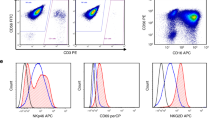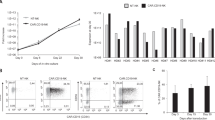Abstract
Previous reports have demonstrated granulocyte– macrophage colony-stimulating factor (GM-CSF)-mediated enhancement of lymphokine activated killer (LAK) cell function. Based on these studies we have developed a model of LAK cell generation from peripheral blood stem cells (PBSC) from cancer patients by in vitro incubation with low-dose interleukin-2 (IL-2) + GM-CSF. PBSC from seven patients were incubated for 48 h at 37°C in serum-free culture medium supplemented with IL-2 at increasing concentrations (10, 100 or 1000 IU/ml) in the presence or absence of 10 IU/ml GM-CSF. LAK activity generated in cultures with 10 IU/ml IL-2 + GM-CSF was significantly higher than that generated by 10 IU/ml IL-2 and did not differ from LAK generation at optimal concentrations of IL-2 (100 and 1000 IU/ml). PBSC from five additional patients were incubated with low-dose IL-2 + GM-CSF after sequential depletion of the CD4+ and CD8+ T cell subsets. LAK activity was significantly reduced by depletion of both CD4+ and CD8+ T cells and almost completely abolished after depletion of both subsets, suggesting that T cells and not NK cells are the main LAK precursors in this model. Six patients have received two courses of LAK cells generated in vitro by low-dose IL-2 + GM-CSF on day +1 and +8 after PBSC transplant in combination with GM-CSF and IL-2 administration in vivo. The mean LAK activity in peripheral blood of these patients dramatically increased immediately after transplant from a mean of 10% to 43.2% on day +2 and remained increased during the period studied. These results are encouraging and suggest that the administration of in vitro generated LAK cells early after transplant may have a role in the control of minimal residual disease.
This is a preview of subscription content, access via your institution
Access options
Subscribe to this journal
Receive 12 print issues and online access
$259.00 per year
only $21.58 per issue
Buy this article
- Purchase on Springer Link
- Instant access to full article PDF
Prices may be subject to local taxes which are calculated during checkout
Similar content being viewed by others
Author information
Authors and Affiliations
Rights and permissions
About this article
Cite this article
Herrera, C., García-Pérez, M., Ramirez, R. et al. Lymphokine-activated killer (LAK) cell generation from peripheral blood stem cells by in vitro incubation with low-dose interleukin-2 plus granulocyte–macrophage colony-stimulating factor. Bone Marrow Transplant 19, 545–551 (1997). https://doi.org/10.1038/sj.bmt.1700698
Received:
Accepted:
Issue Date:
DOI: https://doi.org/10.1038/sj.bmt.1700698
Keywords
This article is cited by
-
A Multicenter Randomized Clinical Trial Evaluating Interleukin-2 Activated Hematopoietic Stem Cell Transplantation and Post-transplant IL-2 for High Risk Breast Cancer Patients
Breast Cancer Research and Treatment (2005)



